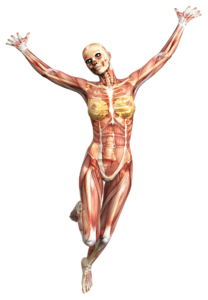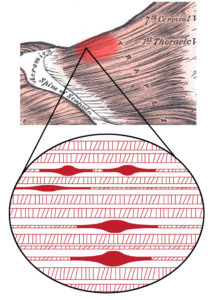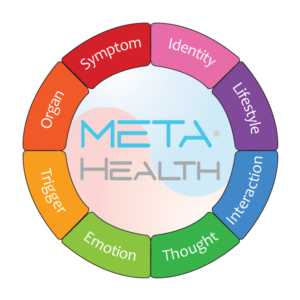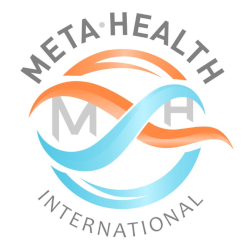This is an excerpt from Gita Jayakumar‘s META-Health Expert thesis.
You can read the whole work and case studies in IMMA’s member’s portal
 A short while ago, I discovered that I had a swelling on the inner side of my left knee. I tried a lot of things, but nothing worked, and it just didn’t budge. I went to my physiotherapist, who suggested that he and I could work on my trigger points to help bring it down. As he worked on my relevant trigger points, I began to see that when he moved from one trigger point to another, there were many UDINs that came up. I kept clearing them, and eventually, my swelling went away. This inspired me to delve deeper into the blend of Trigger Points and META Health for my thesis.
A short while ago, I discovered that I had a swelling on the inner side of my left knee. I tried a lot of things, but nothing worked, and it just didn’t budge. I went to my physiotherapist, who suggested that he and I could work on my trigger points to help bring it down. As he worked on my relevant trigger points, I began to see that when he moved from one trigger point to another, there were many UDINs that came up. I kept clearing them, and eventually, my swelling went away. This inspired me to delve deeper into the blend of Trigger Points and META Health for my thesis.
Trigger points, defined by Janette Travell [1], refer to “hyper irritable spots in the skeletal muscle that is associated with a hypersensitive palpable nodule in a taut band.” In common parlance, they are considered to be knots in the body, and are exceptionally vulnerable to being irritable. They are mostly found in skeletal muscles, and are quite palpable or tangible. These trigger points are, without doubt, painful, especially on compression. The symptomatic manifestation of these points is seen in the form of tenderness, motor or movement dysfunction and even autonomic phenomena.[1] While trigger points generally do share similar symptomatic manifestations, not all of them are same. This is essentially because the cause, manifestation, clinical presentation and approaches to treatment and healing can significantly vary from point to point. Even in size, the average trigger point could be anywhere between a poppy seed, and a pea, or perhaps larger.[1]
Understanding Myofascial Trigger Points

The human body is covered by a soft tissue on its insides. This tissue is known as fascia, and covers every element within the human body – be it a muscle, organ, nerves or even blood vessels. Fascia that specifically covers the muscles in the body are known as myofascia, named thusly because ‘myo’ translates to mean ‘muscles’ and fascia is the tissue itself.
Given that the human body significantly relies on muscles for movement and action, there is vulnerability for wear and tear, for the muscles themselves. The myofascia, as a natural corollary, is equally vulnerable to overuse, wear and tear, trauma and even injury. When any of these things occur, the myofascia begins to adhere, and form something called adhesions, which, in effect, are the trigger points.
Trigger points are the equivalents of the average speed breaker one sees on the roads: they are an obstacle. Trigger points prevent the muscles from working well, and causes a sensation of stiffness and tenderness that increments muscle stiffness and tenderness, while also reduces the range of motion. The discomfort begins to radiate from the trigger point itself.[2]
Broadly speaking, there are two kinds of trigger points – active and latent ones.[2] The active trigger points are situated in the abdominal muscles, and can cause such things as painful menstruation, irritable bowel syndrome, heartburn, excessive gas and flatulence and issues with the bladder.[2] In addition to these issues, they cause fatigue, weakness and tiredness with the muscles that are involved, and they always manifest in the form of outwardly symptoms such as dizziness, numbness, vertigo, along with manifestations specific to the muscles themselves. Latent trigger points, on the other hand, are, as the name suggests, more or less passive trigger points. They cause overall fatigue and weakness in the muscles, but don’t cause pain or other forms of symptoms.
Manifestations of the Myofascial Trigger Points
 A typical myofascial trigger point comprises some characteristics.[2] Primarily, the focal point of the tenderness helps identify the involved muscle. Secondly, the pain increases when there is an application of pressure. Thirdly, a hardened mass forms, in a process known as induration in the muscles adjacent to the trigger point – this is called the taut band.
A typical myofascial trigger point comprises some characteristics.[2] Primarily, the focal point of the tenderness helps identify the involved muscle. Secondly, the pain increases when there is an application of pressure. Thirdly, a hardened mass forms, in a process known as induration in the muscles adjacent to the trigger point – this is called the taut band.
Fourth, this manifests itself in the form of restricted range of movement in the muscles involved. Fifth, a pseudo-weakness in the muscle is seen, without atrophy. Finally, there is pain on the application of continued pressure on the trigger point.
Oftentimes, a myofascial pain syndrome tends to occur because of a single trigger point, but it is more common when there are several trigger points that are responsible for any given pain in a particular part of the body.[3]
Sometimes, it is possible for the problem to be a consequence of a singular trigger point, and then, satellite trigger points evolve with time because of the “mechanical imbalance that stems from a reduced range of movement and pseudo-weakness”.[3]
Myofascial pain manifests in the musculoskeletal system. Problems in the back, hips, jaws, head, neck and shoulder, chest, limbs and joints are a product of these myofascial trigger points.
Combining the knowledge of Myofascial Trigger Points and META Health
Sometimes, pain can result from past injuries without any current reasons for the pain to manifest. Sometimes, this pain may be beyond all residual trauma effects.[4] The rationale of my thesis is to look into the “mind” of the muscle, to assist finding relief and healing from injuries and trauma to the muscles.
The rationale of my thesis is grounded in the science of trigger points.
Cells in the body called proprioceptors function like biological gyroscopes[4], which keep a finger on the pulse and identify joint and muscle activity. They also work to orient the body in the course of its movements, and maintains a state of balance. These cells are often found in joints, and one of these specific kinds are called spindle cells – which works to address contraction when a muscle expands, and another kind is the Golgi tendon, which does the opposite.
When injuries occur, the body, particularly the muscles, remember the action and the injury – and therefore, even after the injury does heal, the spindle cells will automatically contract the moment the body part moves towards the same position it was in when the injury happened. This is called muscle memory.[1]
Since the body had an unpleasant memory in the form of pain, it remembers the pain and triggers it whenever the stress position is experienced. Similarly, UDINS are stored in these trigger points, and form a part of the bigger picture – i.e., the muscle memory.[1]
Healing Trigger Points Using META-Health:
META-Health is among the world’s most diverse and empathy-driven forms of healing, as it relies on the mind-body connection and expands it into the social realm to help the body heal. In effect, it is the art, science and practice of Body-Mind-Social Health with a focus on how specific stress triggers, emotions and beliefs affect specific organ symptoms.[1] In essence, it is a confluence of integrative medicine and prevention, and is a copious tool that assists all kinds of health practitioners who require to put in a precise and effective Body-Mind-Social diagnosis process, and follow it up with appropriate therapy.
In sum, the focus of META-Health is centered around the interconnectedness of the Body-Mind-Social axis and the Art of Self-Healing. Unlike most modern forms of medicine where the healing is symptomatic and attacks the manifestations of disease rather than the disease itself, META-Health is an attempt to attack the disease from its very root, and opens up the channels of the body’s intelligence, its stress triggers and emotions, and allows the individual to take conscious actions towards self-healing and personal growth.
 Since there is a beginning in the awareness of the mind and body’s dialogue, with the social dimension, META-Health opens up an avenue for the multi-dimensional transformation process you will go through to achieve Body-Mind-Social or META-Health. In its approach, META-Health is couched in looking at the bigger picture – the meta perspective – of illness and health, and leaves you with the answers you require in order to heal yourself. It teaches you to find answers for the questions that take you on the right path to healing: Why am I sick? What has triggered my symptoms? Which specific stress and emotions affect my symptoms? Which specific belief and thought patterns do I need to review? What can I do to heal naturally? Which treatments work best for my type of illness? Do lifestyle changes help me heal myself?
Since there is a beginning in the awareness of the mind and body’s dialogue, with the social dimension, META-Health opens up an avenue for the multi-dimensional transformation process you will go through to achieve Body-Mind-Social or META-Health. In its approach, META-Health is couched in looking at the bigger picture – the meta perspective – of illness and health, and leaves you with the answers you require in order to heal yourself. It teaches you to find answers for the questions that take you on the right path to healing: Why am I sick? What has triggered my symptoms? Which specific stress and emotions affect my symptoms? Which specific belief and thought patterns do I need to review? What can I do to heal naturally? Which treatments work best for my type of illness? Do lifestyle changes help me heal myself?
In response, you will be able to evaluate, through a very comforting route, the genesis or root of your emotional trauma. META-Health helps you understand the underlying cause of all diseases, the two phases of a disease process, how each symptom in affected organs relates to a specific conflict and specific part of the brain, the micro organisms as biological helpers and the concept of disease as a intelligent and meaningful process.
Study the methodology of healing!
References:
[1] http://triggerpoint.ca/index.php?p=1_18_Myofascial-Trigger-Points-therapy
[2] https://www.tptherapy.com/instructions/trigger_points
[3] http://www.myalgia.com/Myofascial/Understanding%20MPS.htm
[4] http://healingexperiences.blogspot.in/2010/01/muscle-memory-and-trigger-point-therapy.html
Pictures:
[1] Pexels via Pixabay
https://pixabay.com/en/exercise-workout-yoga-roller-foam-1284370/
[2] Wolfgang Eckert via Pixabay
https://pixabay.com/en/anatomy-female-muscles-skeleton-2901129/
[3] Davidparmenter via Wikimedia Commons
https://upload.wikimedia.org/wikipedia/commons/f/f2/Trigger_Point_Complex.jpg
[4] IMMA

 META-Healthy Life articles are created by professionals and friends of META-Health International CIC, supporting individual and global health by deepening and sharing our understanding of how resilience and well-being are achieved.
META-Healthy Life articles are created by professionals and friends of META-Health International CIC, supporting individual and global health by deepening and sharing our understanding of how resilience and well-being are achieved.